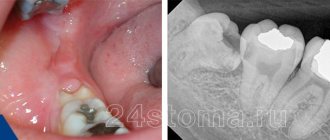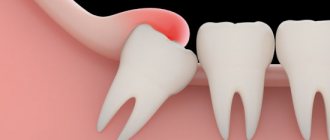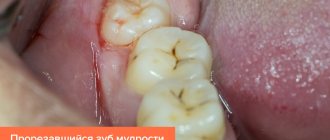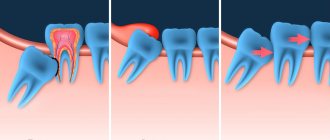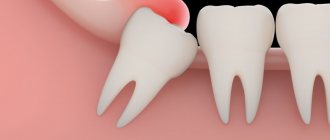A wisdom tooth is the 8th tooth in a row (figure eight) or 3rd molar, its eruption period is 17-25 years. This is a large molar, often with a complex root system. The peculiarities of its development and growth in most cases become the cause of various dental problems. Although the structure of the figure eight is characterized as an ordinary molar, its chewing function is practically absent. If a wisdom tooth hurts, it is rarely preserved. The figure eight is destroyed early, often erupts with a carious lesion, grows at an angle or in a horizontal position.
How can you tell if your wisdom tooth hurts?
Eights erupt much later than all the other teeth in the row, when the dentofacial apparatus is fully formed, and there is simply not enough space for a beginner. Due to the density of the gums and bone tissue, eruption is quite painful, accompanied by inflammation of the gums and damage to neighboring units. Pain during wisdom tooth growth is quite specific:
- Spreads along the jaw, extends to the temple, neck, head, ear, throat;
- around the figure eight there is swelling and redness of the gum tissue;
- due to pain and sore throat, swallowing is difficult;
- numbness of the jaw and severe pain indicate that the 3rd molar is growing crookedly, injuring the jaw nerve;
- it is difficult to open your mouth, especially if the wisdom tooth grows in the opposite direction from the jaw.
Each similar symptom indicates the presence of problems with the 3rd molar. You can temporarily relieve pain when wisdom teeth erupt with an analgesic. If the figure eights grow crookedly, the bite is disturbed, the cheek or gums are injured, they form in the bone tissue without erupting to the surface or appear only partially - they must be removed.
What to do at home
If your gums are swollen and painful, and you cannot visit a doctor in the near future, you should try to reduce the inflammation and relieve the pain. For this purpose it is permissible to use:
- pain medication or NSAIDs, which can be found at the pharmacy;
- anti-inflammatory dental gel (it’s good if it contains an antibiotic);
- rinse solution with antiseptic effect.
If the pain is associated with a removable denture, then it is advisable to remove it. It is important to understand that painkillers and anti-inflammatory drugs should never be taken every day. Their use should be regarded as a “one-time action” when you can’t bear the pain, and you can only see a doctor tomorrow.
It is unacceptable to use oral antibiotics to “silence” inflammation without medical advice. These are systemic drugs with a large number of side effects. Only a doctor can prescribe them during an in-person examination.
Why can a wisdom tooth hurt?
- Non-standard eruption
- impacted teeth formed in the jawbone, not erupted completely or partially, can be positioned horizontally or vertically. When the figure eight is placed on the side, it puts strong pressure on neighboring units, causing acute pain. - Gum hood
– dense gums can prevent teething; a “hood” of mucous tissue forms over the wisdom tooth. Bacteria and food particles begin to accumulate under it, which cannot be removed when brushing your teeth. This area is constantly injured, inflamed, and painful. An acute inflammatory process often develops into a purulent one. - The molar is rotated
around its axis - the more pronounced the rotation, the stronger the impact on the dental nerve, which causes pain in the molar itself, the adjacent unit or the entire jaw. - The cheek hurts
due to a wisdom tooth if it grows in its direction. The pain intensifies when chewing, the mucous membrane of the cheek is constantly injured and inflamed. - Caries
- the localization of the 3rd molar makes it difficult to care for it; often it is cut already with carious lesions of hard tissues, which causes pain. The sensitivity of the tooth increases, it reacts painfully to temperature and chemical stimuli. - Cyst
- due to systematic injury to the gum tissue, the molar itself, a cystic formation may form at the neck. A wisdom tooth cyst is often accompanied by serious complications - inflammation of the periodontal tissues, pericoronitis, abscess, and destruction of bone tissue.
Also, the reason that the wisdom tooth began to hurt are various dental pathologies - pulpitis, periodontitis (acute, chronic), periodontal disease. Removing the figure eight is not always justified; the doctor decides this issue individually, depending on the clinical picture. First, a comprehensive diagnosis is carried out, the doctor determines the location of the roots, assesses the condition of the jaw bone, gums around the figure eight, and the entire dentofacial apparatus.
The main causes of pain
Painful symptoms from wisdom teeth are caused by the anatomical features of the upper and lower jaw, which are already fully formed in a person at the age of 17-25.
As the figure eight begins to grow, it puts pressure on neighboring teeth, bone and soft tissue. The growth process can last for months and even years, so pain manifestations are temporary, periodically fading and exacerbating.
The pain of tooth 8 can be provoked not only by its growth or anatomically incorrect position, but also by the presence of various pathologies, for example, caries, pulpitis, periodontitis or a wide range of infectious diseases. Note! The lack of timely professional help can provoke a worsening of the situation, which will result in the need to remove the diseased tooth and treat complications.
Indications for removal
- Pathological eruption of the figure eight (partial or complete retention, dystopia), accompanied by pain, chronic inflammation of the gums, destruction of adjacent molars, malocclusion, damage to the jaw joint and other problems;
- 3 molar has erupted outside the dentition, leading to crowding;
- inability to carry out treatment or prosthetics due to limited access to the dental unit;
- the presence of complications - cysts, granulomas, periostitis, periodontitis;
- orthodontic treatment - figure eights must be removed if they interfere with the installation of a corrective apparatus or prevent the teeth from taking the correct position when correcting the bite.
How to avoid inflammation
Preventing a disease is always easier than treating it later. To prevent the figure eight from causing discomfort, you must:
- Maintain good oral hygiene. Getting to the last molar is very difficult, often impossible. You need to use special dental brushes, an irrigator, rinses, and floss.
- Do not take hormonal medications without a doctor's prescription. If long-term treatment with hormones is planned, you need to periodically take blood tests to monitor your health.
- Eat right, eat plenty of fresh fruits and vegetables. Once or twice a year, it is advisable to take a course of vitamins and minerals selected by a therapist. Ascorbic acid is very beneficial for gums. It does not allow increased bleeding to develop.
- Stop smoking and drinking alcohol. Because of these bad habits, the condition of the oral mucosa worsens, local blood circulation is impaired, and wounds heal more slowly.
- Massage your gums every day. You can do it yourself. First you need to wash your hands, and then use your fingertips to gently massage all areas of the mouth one by one.
- Buy a new brush every three months. Give preference to high-quality and proven pastes.
It is very useful to rinse with plain warm water after each meal. This will allow you to remove food debris in a timely manner.
If the gum tissue becomes inflamed at the base of the wisdom tooth, you should immediately make an appointment with the dentist. Self-medication can be dangerous.
When do you need a doctor's help?
If the figure eight hurts, you should immediately consult a dentist. Consultation with a specialist is also necessary for pain of unknown etiology - squeezing, spreading over the entire jaw, occurring when chewing or opening the mouth. After examination and diagnosis, the doctor will decide what to do next with the molar. If the growth of a wisdom tooth is accompanied by swelling, redness of the gums, and acute pain, the doctor will prescribe anti-inflammatory therapy.
If eruption is difficult due to the gingival hood, an operation will be performed to excise it and drug therapy will be prescribed.
Signs of inflammation
Inflammatory reactions at the base of the third molar manifest themselves as follows:
- aching or sharp pain;
- an increase in the volume of soft tissues (they seem to increase in size, become taller);
- redness of the mucous membrane;
- swelling of the cheek;
- unit mobility;
- discomfort when pressing;
- enlarged cervical lymph nodes;
- bleeding, bad breath;
- pulsation and burning in the mouth on the affected side;
- the formation of fistulas through which pus and bloody exudate come out;
- hyperthermia of the inflamed area.
Often there are no accompanying symptoms. Then the patient complains only of discomfort at the base of the figure eight.
Wisdom teeth removal methods
The intervention tactics depend on the location of the 3rd molar, the degree of exposure to the gum surface, the number of roots, their confusion, and the position of adjacent teeth. Removing figure eights on the upper jaw is easier than on the lower jaw. This is due to the structure of the jaw tissue - the maxillary bone is looser, more airy, the mandibular bone is more massive and dense. Additionally, mandibular eights tend to have more tangled and developed roots.
According to the clinical picture, removal can be simple or complex. A simple extraction is performed like any other extraction - the molar is rocked with forceps and removed from the socket. Complex technology includes:
- gum incision;
- drilling a molar or sawing it into fragments;
- removing each fragment one by one;
- suturing the wound.
Stitches are removed on days 5-7
after the intervention (self-absorbable suture material can be used). The operation is performed under local anesthesia; removal under sedation (during medicinal sleep) is possible.
Treatment of wisdom teeth during pregnancy has its own nuances. Usually, the doctor limits himself to conservative therapy aimed at eliminating pain and inflammation. If possible, removal is performed after childbirth. The operation is carried out according to strict indications, if the inflammation has become purulent and threatens the health of the mother and child. For anesthesia, special drugs are used that are safe for the fetus.
At the RUTT clinic, the removal of a wisdom tooth with a complex root system and location is performed by experienced maxillofacial surgeons. This eliminates surgical complications - extensive trauma to the bone structures of the jaw, perforations, wandering root remains, postoperative fistulas, osteomyelitis, etc. Only maxillofacial surgeons have enough skills and experience to perform such interventions without complications.
In what cases is it better to remove a tooth?
Old school dentists insist that at the first discomfort of the patient, wisdom teeth should be removed without regret. Modern dentistry is more humane and is convinced of the need for strict indications for the procedure, rightly noting that in due time “eights” may become the only possible support for dentures.
Indications for removal are:
- eruption of the third molar outside the dentition;
- threat of displacement of adjacent teeth;
- abnormal position of the crown and pressure on the second molar;
- impossibility of therapeutic treatment of the tooth.
Today, at the first visit with complaints of pain caused by the “eight”, the dentist first takes an x-ray to examine the position of the roots, the shape of the tooth and its condition. And only then evaluates all the risks. With this approach, a wait-and-see tactic is increasingly being chosen: the doctor selects painkillers that will help survive the pain that is natural to the teething process. If necessary, incises the gum and cuts off the hood. And then for several months he observes how the wisdom tooth will behave.
Dentists of the Israeli school even fight for impacted wisdom teeth, pulling them out and putting them in the right place with the help of orthodontic instruments. The main thing is that there is enough space in the patient's jaw.
Is it painful to have a wisdom tooth removed?
26% of operations to remove “eights” are no different from the removal of other molars. The wisdom tooth is simply pulled out using hand forceps after local anesthesia is administered. In this case, the patient, as a rule, does not even have time to get scared, the whole procedure goes so quickly.
Another thing is difficult removal. This operation can last up to 40 minutes, during which the surgeon saws the tooth with a drill and takes it out in parts. Unfortunately, this is the only way to remove a tooth that lies horizontally, or has frozen in its development, and has not erupted, but due to its location causes constant pain.
And even in this case, modern anesthesia can completely relieve pain. The same applies to the recovery period. First, in most cases, the surgeon will stitch up the resulting wound, speeding up the healing process. Secondly, he will prescribe painkillers for the coming days. Therefore, you should not be afraid of removal - it will cause much less pain than regular exacerbations.
Recovery after surgery
The removal of the figure eight itself is painless, since it is performed under anesthesia. But due to injury to the gums and bone socket, after the anesthetic wears off, the figure eight, or rather the periodontal tissues, hurt for several days. Painful sensations after a simple removal usually go away within 2-3 days, after a complex one they can persist for about a week. On days 2-3, swelling increases, which subsides after 2 days and the pain subsides. After the intervention, the doctor gives recommendations regarding care, nutrition, lifestyle, and prescribes drug therapy - antibiotics, painkillers, anti-inflammatory drugs, antihistamines.
How to relieve pain?
At the first unpleasant sensations from a growing wisdom tooth, frequent rinsing with Chlorhexidine, Miramistin or Eludril solution helps. If you can’t run to the pharmacy, you can prepare a soda-salt solution: dissolve 1 teaspoon of soda and salt in one glass of warm boiled water.
Supporters of traditional methods can use oak bark, sage and chamomile. To do this, you need to take 3-4 tablespoons of the mixture, composed in equal proportions, and pour 500 ml of boiling water. Leave for an hour and strain before using.
Rinses are effective only if the pain is caused by the natural process of tooth eruption. All of the listed drugs, both pharmaceutical and home-made, relieve swelling well and suppress the activity of pathogenic microflora in the oral cavity.
If symptoms of an attached infection have already developed: fever, swelling, severe swelling, surgical intervention will most likely be required: removal of either the hood or the tooth itself. In order to reduce the risk of complications, the doctor will definitely prescribe antibiotics.
Please note: it is strictly forbidden to prescribe antibiotics to yourself!
But painkillers should be taken before visiting the doctor. In this case, the following are effective:
- Broad spectrum analgesics
. Analgin, Ketanov, Paracetamol relieve pain for several hours, usually from 1 to 5. It is also possible that the tablet will not work at all. You can increase the dose, the main thing is to strictly follow the instructions. - Anti-inflammatory drugs.
Nurofen, Ibuprofen, Diclofenac can not only provide a powerful analgesic effect, but also relieve fever and reduce swelling. - Ointments, gels, sprays for topical use
. Holisal, Metrogyl Denta, Kamistad, Angilex “freeze” any sensations in the sore gum for 2-3 hours.
An ordinary piece of ice relieves pain well. It needs to be wrapped in a cloth and applied to the external projection of the diseased tooth on the cheek. Hold for no more than 5-7 minutes. Do not put ice directly on the gum. Its tissues are too delicate and direct contact can lead to necrosis.
The most original folk method of getting rid of toothache when a wisdom tooth comes out: take a plantain leaf, wash it and roll it into a tube. Then you need to insert the sheet into the auricle, but always on the side on which the tooth hurts. Dentists call such methods useless. But this method does not cause any harm. So why not try?!
Where can the pain go?
Quite often, the process of growth of eights is accompanied by uncharacteristic symptoms. Moreover, some of them are due to the growth of the molar itself, and the other part indicates the development of complications. Let's take a closer look - can a wisdom tooth give into...?
- Head
- in case of complicated teething it can. - Eye
– with complicated eruption of the upper molars and the development of an abscess, it can. - Tongue
- a symptom indicates the presence of purulent inflammation of the soft tissues closer to the tongue. - Ear
– indicates the development of inflammation, pulpitis or dental cyst. - Throat
- most likely we are talking about pulpitis. - Jaw
- a symptom characteristic of complicated teething and inflammation. - The neck
is unlikely, unless we are talking about the spread of infection and inflammation of the lymph nodes. - Temple
– Clicking and pain in the temple may be present due to tension in the temporomandibular joint, which occurs from constant pain. - The teeth are nearby
- of course, because the figure eight can put pressure on them.
Important! The above list is a serious signal to contact a dentist. Don't delay your visit to the clinic!
How to deal with the problem
What to do if “eights” are painfully “born”: at home you can relieve unpleasant symptoms (in the absence of pathological processes), and then seek help from a doctor. So, independent treatment involves taking painkillers (Analgin, Paracetamol, Ketanov, Nimesil), using local anti-inflammatory ointments, gels (also provide pain relief) - Kamistad, Cholisal, Metrogyl Denta, Kalgel, rinsing the mouth with antiseptic solutions (Chlorhexidine, Furacilin, Miramistin) .
Prevention
Thorough oral hygiene, brushing your teeth 2 times a day, regular visits to the dentist and treatment of any “local” diseases will help avoid the development of an inflammatory process during the eruption of third molars. In addition, for the overall health of the body and minimizing the risk of developing any dental diseases, it is recommended to take regular courses of multivitamin complexes (pay special attention to calcium, potassium, magnesium, ascorbic acid), give up bad habits, follow a daily routine and, if possible, avoid stress.
So, discomfort in the area of growing “eights” may be a variant of the norm - this is how soft tissues “respond” to microtraumas that occur during teething. If pain and swelling persist for a long time, are accompanied by weakness, hyperthermia, swelling of the gums (cheeks), and, in addition, a purulent sac appears in the affected area, we are talking about a pathological inflammatory process that requires immediate treatment. In the absence of timely medical intervention, such pathological changes can result in phlegmon, abscess, periostitis and other complications.
Pain during caries, pulpitis and periodontitis -
In the absence of symptoms of teething and inflammation, pain can only be associated with some kind of dental disease, for example, it could be caries or pulpitis. Before starting treatment, it is necessary to generally decide on the advisability of maintaining it. After all, there are often situations when expensive treatment is carried out on a tooth that is of no value either from a functional point of view or from the point of view of the need to use the tooth in the future for prosthetics.
- Wisdom teeth caries – symptoms may include pain in response to sour, sweet foods, and cold irritants. Such pain goes away immediately after the irritant stops working. It is up to the dentist to decide whether to treat or remove such a tooth. This will depend on the correct position of the tooth, whether it is needed for prosthetics, etc. However, in some cases, determining the cause of pain (as well as the causative tooth) can be quite difficult.
For example, there are situations when an erupting wisdom tooth presses its crown onto the seventh tooth in front, causing its destruction. In this case, the carious lesion is located on the far surface of the seventh tooth near the gum or even just below it. This can usually be diagnosed using an x-ray. On the radiographs below, you can see carious lesions that look like intense darkening (indicated by arrows).
- Pulpitis of wisdom teeth – → with acute pulpitis, patients may experience acute, paroxysmal pain.
As a rule, pain is spontaneous, i.e. occur spontaneously, without any irritants. And if with caries the pain goes away immediately after the thermal irritant has been removed, then with pulpitis the pain does not go away even after the irritant is removed and can last about another 10-15 minutes. At night, the pain usually increases. → with chronic pulpitis of the wisdom tooth, the main symptom is also pain, but it will no longer be as pronounced. The pain will be aching and occur periodically. It can be provoked by cold and heat irritants. After eliminating the irritants, the pain does not go away immediately, but after 10-15 minutes. If your wisdom tooth is aching, then it is likely that this is a chronic form of pulpitis (24stoma.ru). - Periodontitis of the wisdom tooth – → with acute periodontitis, patients usually complain of aching pain, which is clearly localized in the wisdom tooth.
Biting on a tooth causes a sharp increase in pain. Swelling of the gums/cheeks may appear in the projection of the causative tooth. If your wisdom tooth hurts, your gums hurt, there is swelling of the gums near the tooth on the buccal or lingual side, then it is quite possible that this is an acute form of periodontitis. → with chronic periodontitis there are often no symptoms at all. Sometimes there may be painful biting on the tooth, as well as tapping on it. But the pain in this case is not very strong. There may be a fistula on the gum in the projection of the wisdom tooth, from which scanty purulent discharge will be released.
What remedies will not be effective?
In most cases, it is impossible to remove the pain syndrome associated with the development of inflammation with the help of rinses, ointments, and antibiotics. The main treatment here will be excision of the hood over the wisdom tooth. Self-medication, at best, will reduce symptoms for a certain period, but at worst, it will lead to complications. We hope that our article was useful to you!
Sources:
1. Higher prof. the author's education in surgical dentistry, 2. Based on personal experience as a dental surgeon, 3. National Library of Medicine (USA), 4. “Pathology of wisdom teeth eruption” (Rudenko A.), 5. “Qualified removal of third molars” ( Asanami S.).
Consequences of failing to see a doctor promptly
If you turned to a specialist for help late, then most likely you may subsequently encounter pathological phenomena in the oral cavity such as caries of the wisdom tooth itself or adjacent teeth, the development of various periodontal diseases, pericoronitis, displacement or significant damage to neighboring teeth.
During the active stage of growth, the gums may bleed, it becomes painful to swallow, and when you press on the gums, purulent discharge is possible.
There are also frequent cases when the cheek, tongue, gums are swollen as a result of pathogenic processes, or even the lymph node is inflamed.
The eruption of a wisdom tooth often provokes fever and severe headache, which can only be relieved with painkillers. This process cannot be started, as this will lead to the early loss of 7 teeth in a row that are in contact with the wisdom tooth. There is also compaction of the soft tissues of the gums or cheeks, cysts, neuritis, crowding of teeth, leading to their modification and degeneration, developing into benign or malignant neoplasms, inflammation in the bony part of the jaw is also common.
In general, when a wisdom tooth hurts, this is a direct signal that you need to act quickly! Only a dentist can help you solve this problem quickly and as efficiently as possible.


